
Flowering Hedges: Where to Start
Published: 27/02/2024 | Updated: 18/12/2025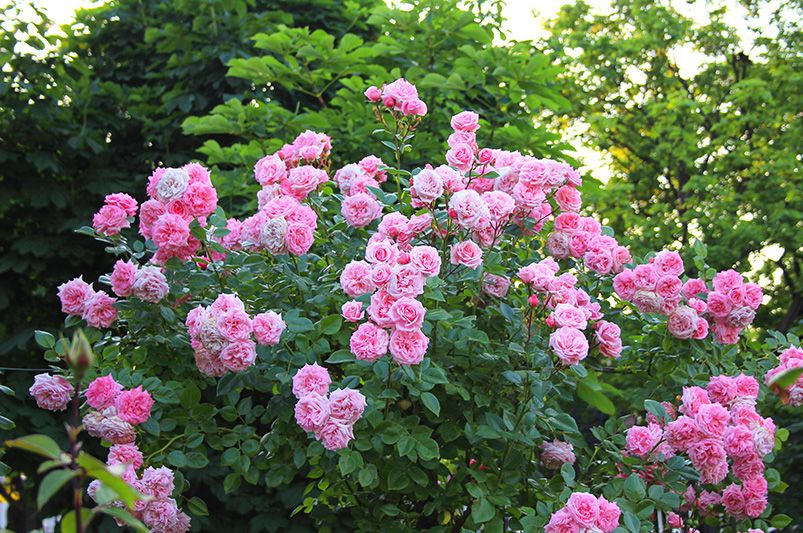
Flower hedges are a beautiful and versatile way to add color, privacy, and structure to your garden or landscape. There are many ways you could utilize them around your landscape, from planting them in rows to having a flower barrier, defining spaces, providing wind and noise reduction, or even creating a little wildlife sanctuary and attracting pollinators to your garden. Whatever it is, you'll be sure to have visual interest in your garden all year round.


When choosing flower hedges, it's important to consider your specific gardening conditions and preferences, however.
As you get into our favorite flowering shrubs and hedges to fill your garden with beautiful flowers and endless bloom, also check our weekly blog for tips and tricks as well as valuable landscape-care knowledge. We cover everything related to gardening and hard landscaping.
Top Flowering Hedges to Consider
In the recommended list of flowering hedges and blooming shrubs we have for you, there is enough variety to match most USDA hardiness zones and different climate conditions.
Here are our recommended flowering hedges:
Rose (Rosa spp.):
What could this list start with if not roses? Shrub roses are a classic, stunning choice. You get the usefulness of hedges and the elegant beauty of roses.
Against the dark green foliage, you get a variety of colors and fragrances according to your preferences. From pure white flowers to attention-catching red roses, this flowering hedge has much to offer.
When it comes to size, they also vary greatly; they range from 2-3 feet tall to 8-10 feet tall. Of course, if you want a dense growth for privacy reasons, the larger varieties, with particular pruning care are recommended.
But generally, the rose hedge is a low-maintenance plant. It tends to prefer the full sun but can tolerate part shade, and evenly moist, well-drained soil.
Some popular types of roses for hedges include rugosas, hybrid teas, and floribundas.
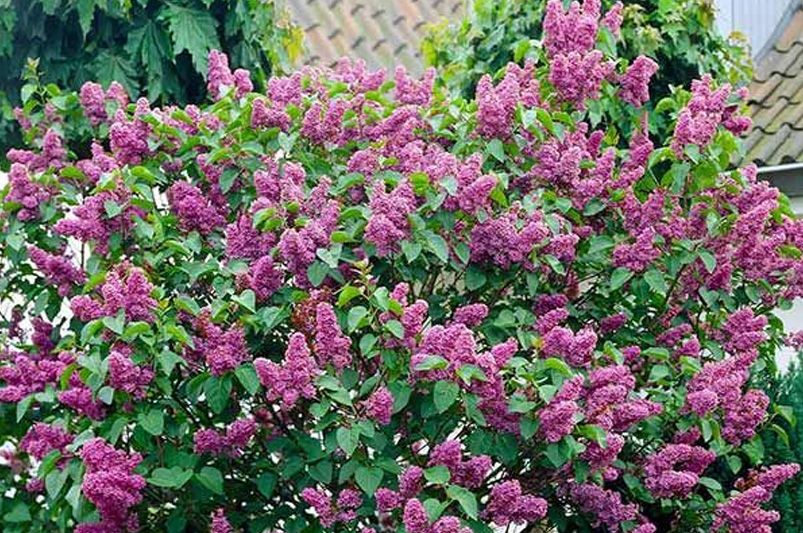
Lilac (Syringa spp.):
Those shrub blooms make very showy flowers. The shrubs themselves are deciduous. In spring, the flowers bloom with fragrant clusters.
Lilac varieties technically belong to the olive family. This flowering hedge fills the garden with stunning purple flowers and can grow to 12 feet tall with an average of 8 feet, making excellent hedge plants.
When planting a lilac hedge, it's important to consider the spacing between the bushes. Otherwise, they don't need any special care.
To care for lilac hedges and shrubs, you only need to keep the grass from growing around them. They prefer the sun to part shade and moist well-drained soil.
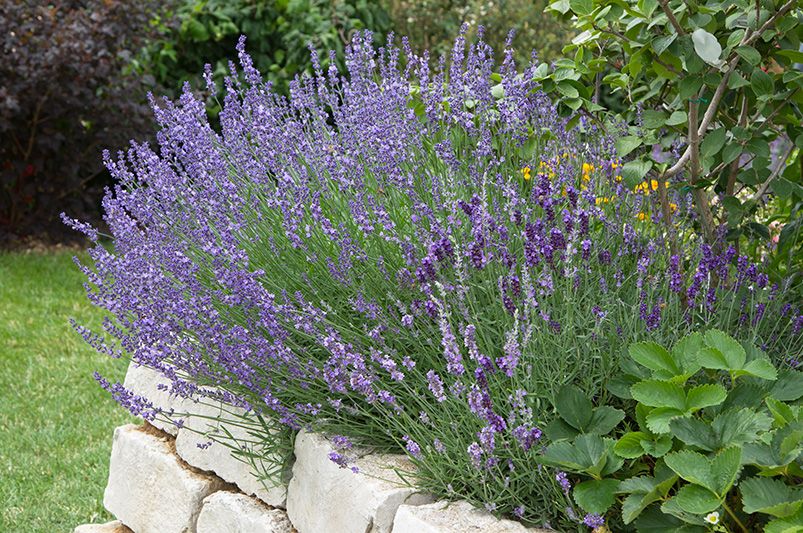
Lavender (Lavandula spp.)
Lavender (Lavandula) is a versatile plant that is often used for its fragrance, and soothing properties, and as a decorative plant. While the collective image of lavender hedges is that of purple flowers, this plant blooms actually with a large variety of colors, ranging from sky blue to creamy white flowers.
This flowering hedge usually grows up to three feet tall, but you can create a barrier by planting a cluster of hedges close together.
Those flowering hedges do well in a sunny location with moist, well-drained soil. You'll need to water it regularly during its first growing season, but once established, it's drought-tolerant.
When pruning, avoid cutting into old wood or cutting too much at any one time as this may damage the plant.
It's also important to prune lavender regularly to keep its shape and promote healthy growth. The best time to prune your lavender is right after it has finished blooming or in early spring before new growth.
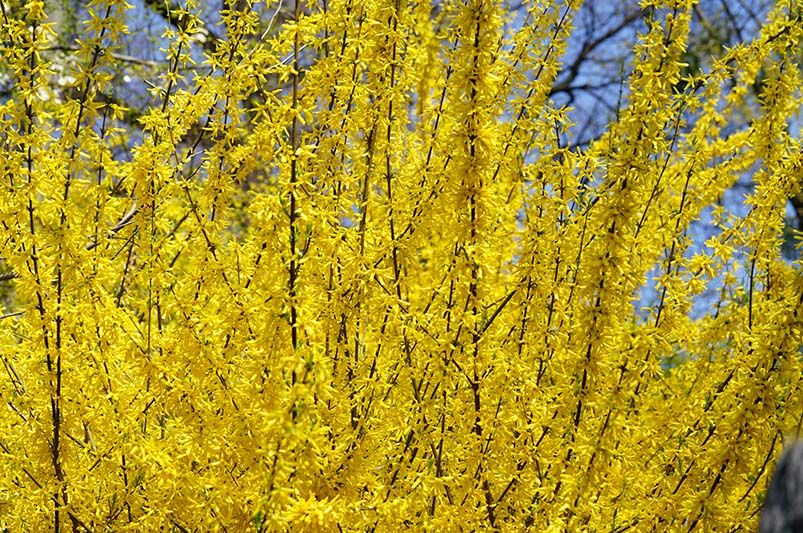
Forsythia (Forsythia spp.)
Forsythia hedges are known for their vibrant yellow flowers which bloom in early spring, making the forsythia an incredibly attractive hedge.
To create a Forsythia hedge, plant at a spacing of three to four feet apart. This flowering shrub prefers well-drained soil with level moisture and full sun exposure.
Forsythia typically grows to a height and width of six to ten feet and requires regular pruning to keep its shape and promote healthy growth. You can also prune for a desired shape, like arched or squared.
When pruning, remove old or damaged growth and thin out any weaker branches to allow for better light and air circulation. Avoid cutting the older stems, as they may not grow back. Pruning can be done in the late winter or early spring.
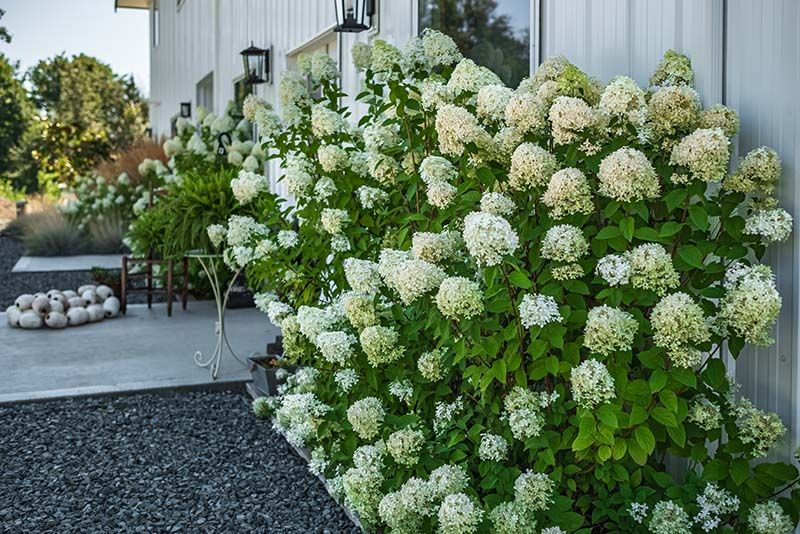
Hydrangea (Hydrangea spp.)
Hydrangea flowers are among the most beloved flowers. Hydrangeas are popular shrubs known for their showy blooms and come in a variety of colors and types.
To create a hydrangea hedge, you will need to choose the right variety of hydrangeas, as some are more suitable for hedging than others.
Look for compact and bushy varieties with a dense growth habit and strong branches that can support the weight of the blooms. For example, Hydrangea macrophylla and lacecap hydrangeas are very suitable.
While some varieties are fine with moist to wet soil, most prefer soil but well-drained soil. Mulching around the plants is a good idea to retain moisture as well as suppress weed growth.
Pruning is another important aspect of maintaining a hydrangea hedge. Different hydrangea varieties require different pruning techniques, so it's crucial to understand the specific needs of your chosen hydrangea species.
Generally, pruning is done in late winter or early spring, before new growth begins in mid to late spring.
Remember to fertilize your hydrangea hedge to promote healthy growth and vibrant flowers. Choose a balanced, slow-release fertilizer specifically formulated for hydrangeas and apply it accordingly.
Camellia
This evergreen shrub is a genus of flowering plants in the family Theaceae and includes many species and cultivars that offer a wide range of beautiful blooms.
Camellias are known for their attractive glossy foliage, and they produce stunning flowers in various colors, including shades of white, pink, and red.
Depending on the specific cultivar, this evergreen hedge can bloom from late fall through early spring, adding color and beauty to the landscape during the colder months.
Camellias are versatile and can be used in various ways in the garden. They can be grown as standalone shrubs, planted in groups to form hedges or screens, or even trained into espaliers or topiaries. Their dense foliage also provides year-round privacy and acts as a great backdrop for other garden plants.
These evergreen shrubs prefer slightly acidic, well-draining soil and partial shade to thrive. They require regular watering, especially during dry periods, to ensure that the soil remains consistently moist.
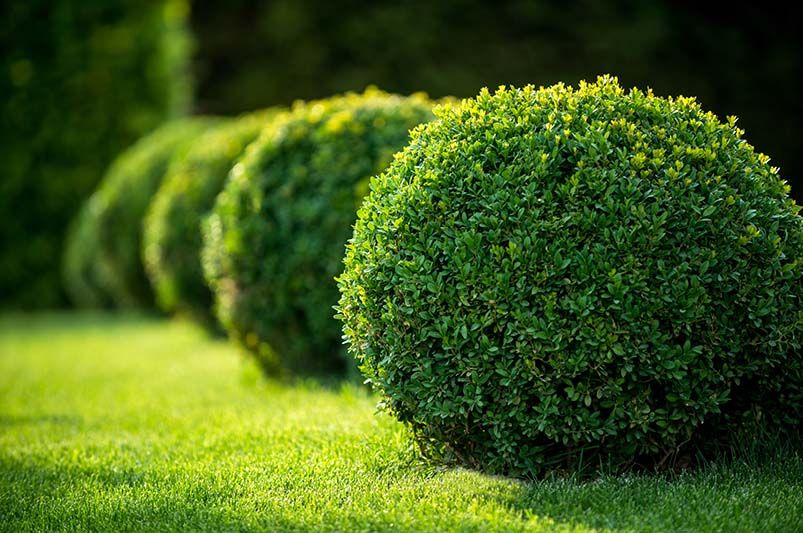
Boxwood (Buxus spp.)
Boxwoods are evergreen shrubs known for their dense foliage and ability to be easily shaped and pruned into formal hedges or topiaries. They're commonly used for hedging due to their compact growth habit and tolerance for frequent pruning.
The English Boxwood, the type most used for hedging, has small, glossy leaves and can be shaped into a formal hedge or left to grow naturally as a more informal hedge.
The flowers of boxwoods are generally small, inconspicuous, and not the main attraction of these plants. However, they add a touch of charm when they bloom in late spring or early summer. The flowers are usually white or greenish-yellow, and while they may not be showy, they do provide a subtle beauty to the hedge.
They prefer partial shade to full sun and well-drained soil.
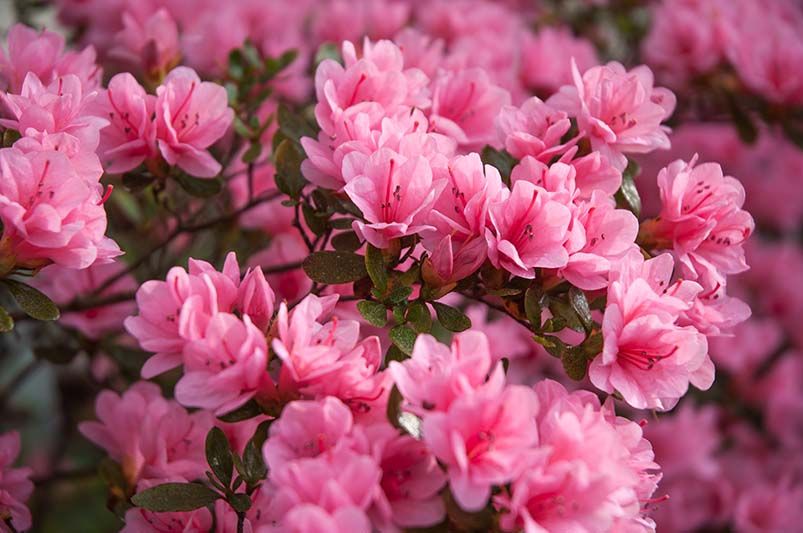
Azalea (Rhododendron spp.)
An Azalea flowering hedge is a beautiful addition to any garden or landscape. Azaleas are popular shrubs known for their vibrant and showy blooms, which typically come in shades of pink, red, purple, and white.
When arranged in a hedge, Azaleas can create a stunning visual display that provides year-round interest for your outdoor space.
As deciduous or evergreen shrubs, Azaleas offer varying degrees of foliage throughout the year, and their blooms typically appear in the spring or early summer
Depending on the species and cultivar, Azaleas can grow to different sizes and have different watering and care requirements, so be sure to choose the right one for your climate and soil conditions.
Pruning is an essential aspect of maintaining an Azalea hedge, as it helps to shape the hedge and promote healthy growth and blooming. The best time to prune Azaleas is after they have finished flowering.
Remove any dead or diseased branches, and selectively prune to promote branching, which can lead to more abundant blooms the following year.
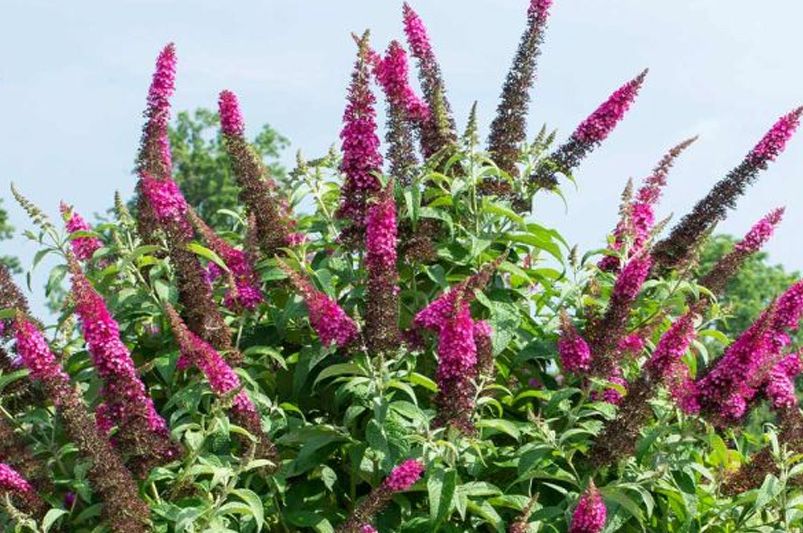
Butterfly bush (Buddleja spp.)
Butterfly bushes, also known as Buddleia, are deciduous shrubs known for their long, showy panicles of fragrant flowers that bloom in various colors, including pink, purple, white, and red. As well as butterflies, they attract bees and other pollinators.
To create a Butterfly bush hedge, you will need to choose a suitable location that receives full sun for at least six hours a day and has well-drained soil. Space the plants at least 3-5 feet apart.
Pruning is also essential for maintaining a Butterfly bush hedge. Depending on the variety you select, you may need to prune during the winter or early spring to shape and control the size of the shrubs.
Deadheading spent blooms can promote continuous blooming throughout the growing season, and the removal of old, woody stems can encourage new growth and healthier foliage.
As Butterfly bushes are deciduous shrubs, they may not provide year-round screening like evergreen shrubs. However, their colorful blooms and butterfly-attracting properties more than makeup for that, as they add beauty and interest to your landscape throughout the growing season.
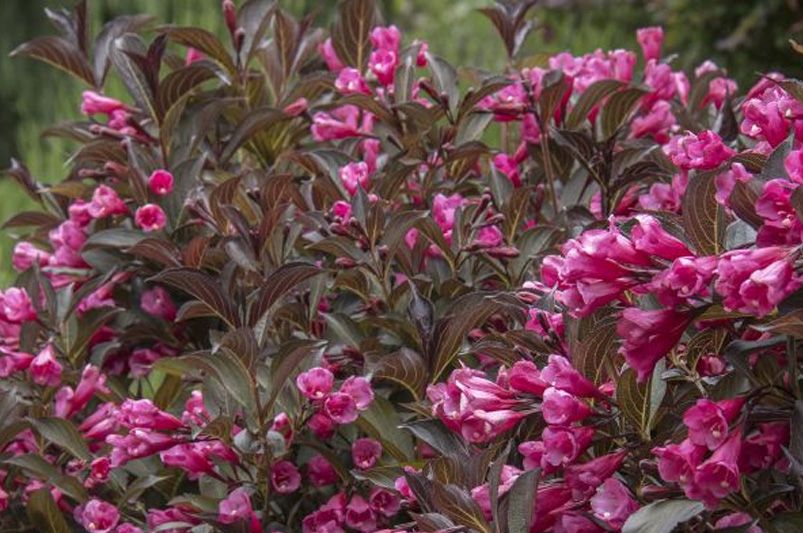
Weigela (Weigela spp.)
Weigelas offers trumpet-shaped flowers in a range of colors. A Weigela flowering hedge can be a stunning addition to your garden. This deciduous shrub can produce profuse clusters of flowers in spring.
To create a Weigela flowering hedge, choose a suitable location that receives full sun to ensure the best flowering.
Weigela is generally versatile and can grow in both sun and partial shade, however. In hot regions, partial shade is preferred.
Weigela bushes are relatively low-maintenance. They require regular watering, especially during dry spells. Pruning is also important for maintaining the shape and promoting healthy growth.
Prune the plants after they finish flowering to remove dead or damaged branches or prune for shape and size. Weigela is also known for its deer resistance.
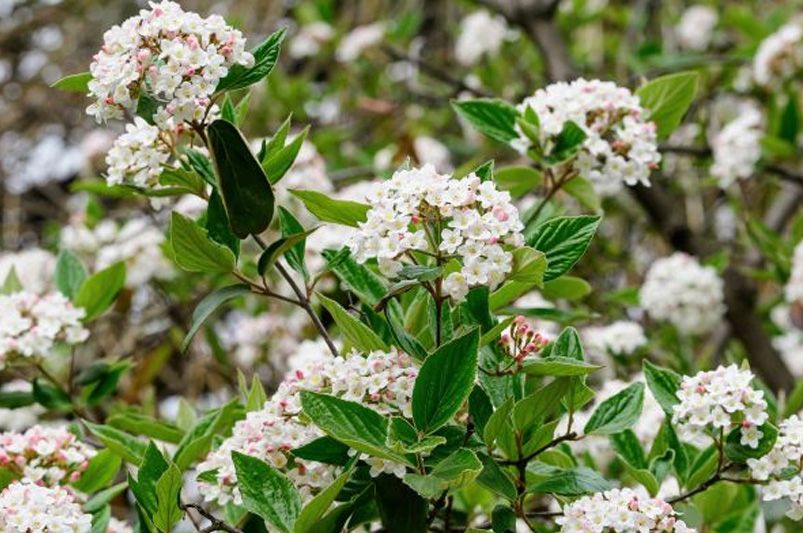
Viburnum (Viburnum spp.)
Viburnums are versatile shrubs with clusters of fragrant flowers. Viburnums produce showy clusters of flowers in the spring, followed by red or black berries in the fall.
To create a Viburnum flowering hedge, choose a location that receives partial to full sun, depending on the specific variety of Viburnum you select.
Provide the shrubs with well-drained soil that is enriched with organic matter, such as compost or leaf mold. Viburnums are generally low-maintenance shrubs that only require regular watering and fertilization.
Pruning is also essential for maintaining an attractive Viburnum flowering hedge. Generally, Viburnums can withstand heavy pruning and can be pruned back hard in late winter or early spring to encourage dense, bushy growth and increase flowering.
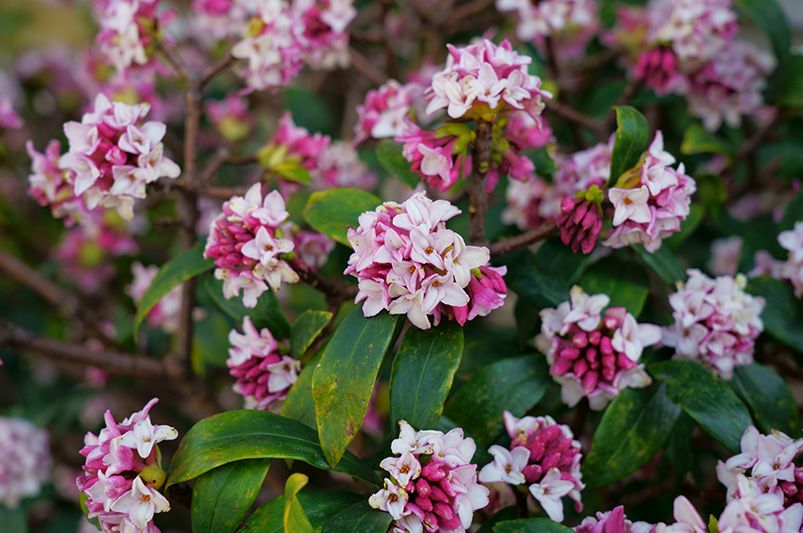
Daphne
Daphne is a fragrant flowering shrub that produces clusters of small, colorful flowers. They're their fragrant and attractive flowers, which bloom in late winter or early spring.
They may work well for use as a mixed border or as low-growing specimen plants in a garden.
If you would like to try Daphne as a hedge plant, it is best to choose one of the more compact varieties, such as Daphne odora or Daphne x burkwoodii.
These plants can produce dense growth and may be more suited for the role. It is important to keep in mind that Daphne plants prefer well-drained soil and moderate watering, and may require pruning to maintain their size and shape
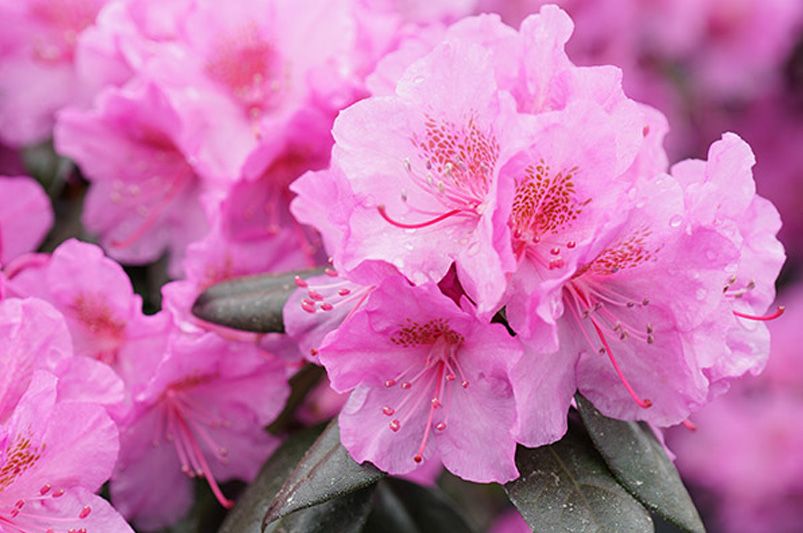
Rhododendron
Rhododendrons can be used as flowering hedges and are popular for their stunning blooms and attractive foliage.
They come in a range of flower colors, including pink, purple, red, white, and yellow. Rhododendrons prefer climates with moderate rainfall and moist, temperate summers.
Their large flowers bloom in a variety of colors, and they have a range of sizes to choose from.
They are low-maintenance plants as well.
Some rhododendrons have a more upright and dense growth habit, making them better suited for hedges. Examples of suitable rhododendron varieties for hedges include 'PJM Elite,' 'Nova Zembla,' and 'English Roseum'.
Rhododendrons prefer well-drained, acidic soil, so it's important to prepare the planting area accordingly. Regular watering and mulching will help maintain soil moisture, as rhododendrons have shallow root systems.
Pruning is essential to shape and maintain the desired size of the rhododendron hedge. It is best to prune immediately after flowering to avoid removing potential flower buds for the following year.
Rhododendrons can be toxic to pets, so be careful if you do have any pets.

Rose of Sharon
Rose of Sharon is a beautiful deciduous flowering shrub that produces abundant blooms in the summer and fall. The flowers are large and showy, with prominent stamen, and come in a variety of colors.
This plant is known for its tolerance to heat, humidity, and drought, and it can tolerate a range of soil types as well.
Rose of Sharon plants should be planted in an area with full sun exposure as they require at least six hours of direct sunlight daily to bloom profusely. They also prefer well-draining soil with regular water needs.
The plant is a prolific grower, which makes it perfect for use as a hedge plant, and when pruned regularly.
The specific selection of great flowering shrubs may vary depending on your climate, soil conditions, and personal preferences. However, this list offers you a diverse enough variety of flowering hedges so that you can choose based on both preferences and suitability. There are endless flowering hedges to choose from. You can browse and explore more on our Shrubhub garden marketplace.
To grow your favorite flowering hedges and fill your landscape with color and vibrancy, you need to have a suitable landscape design. There's no better time than now to start thinking of your new landscape design, especially as we're offering a 70% discount on all our design services at Shrubhub. This includes both 2D and 3D landscape design services.
All you'd need to do is sign up here and a professional designer from our team will contact you as soon as possible.


